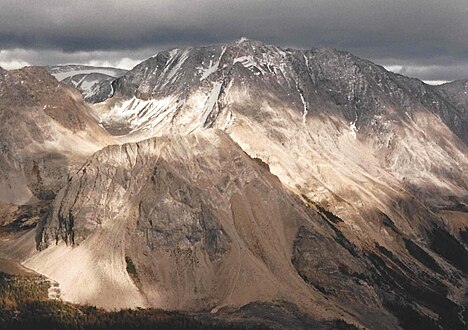Lychnis Mountain
| Lychnis Mountain | |
|---|---|
 Lychnis Mountain centered in the distance behind Tilted Mountain and Baker Lake | |
| Highest point | |
| Elevation | 3,124 m (10,249 ft)[1] |
| Prominence | 244 m (801 ft)[1] |
| Parent peak | Mount St. Bride (3394 m)[1] |
| Listing | Mountains of Alberta |
| Coordinates | 51°28′55″N 115°58′10″W / 51.48194°N 115.96944°W[2] |
| Geography | |
| Location | Alberta, Canada |
| Parent range | Sawback Range Canadian Rockies |
| Topo map | NTS 82O5 Castle Mountain[2] |
| Geology | |
| Rock age | Cambrian |
| Rock type | Sedimentary rock |
| Climbing | |
| First ascent | 1969 A.J. Kauffmann, W.L. Putnam, L. Putnam, L.R. Wallace[3] |
Lychnis Mountain is a 3,124-metre (10,249-foot) mountain summit located in Banff National Park, in the Canadian Rockies of Alberta, Canada. It is part of the Sawback Range. Its nearest higher peak is Mount St. Bride, 3.1 km (1.9 mi) to the north.[1] The mountain is situated 2.0 km (1.2 mi) east of Tilted Mountain in an area of exposed Skoki Formation limestone which is known for fossils such as brachiopods, gastropods, conodonts, cephalopods, trilobites, and echinoderm fragments.[4]
History
[edit]Lychnis Mountain was named in 1911 by James F. Porter for the alpine flower Lychnis.[3]
The mountain's name was officially adopted in 1956 when approved by the Geographical Names Board of Canada.[2]
The first ascent of the mountain was made in 1969 by A.J. Kauffmann, W.L. Putnam, L. Putnam, and L.R. Wallace.[3]
Geology
[edit]Like other mountains in Banff Park, Lychnis Mountain is composed of sedimentary rock laid down during the Precambrian to Jurassic periods.[5] Formed in shallow seas, this sedimentary rock was pushed east and over the top of younger rock during the Laramide orogeny.[6]
Climate
[edit]Based on the Köppen climate classification, Lychnis Mountain is located in a subarctic climate with cold, snowy winters, and mild summers.[7] Temperatures can drop below −20 °C with wind chill factors below −30 °C.
References
[edit]- ^ a b c d "Lychnis Mountain". Bivouac.com. Retrieved 2019-02-16.
- ^ a b c "Lychnis Mountain". Geographical Names Data Base. Natural Resources Canada. Retrieved 2019-03-16.
- ^ a b c "Lychnis Mountain". cdnrockiesdatabases.ca. Retrieved 2019-09-21.
- ^ "Skoki Formation". Natural Resources Canada. 2014. Retrieved 2019-09-21.
- ^ Belyea, Helen R. (1960). The Story of the Mountains in Banff National Park (PDF). parkscanadahistory.com (Report). Ottawa: Geological Survey of Canada. Archived (PDF) from the original on 2015-10-02. Retrieved 2019-09-13.
- ^ Gadd, Ben (2008). Geology of the Rocky Mountains and Columbias.
- ^ Peel, M. C.; Finlayson, B. L.; McMahon, T. A. (2007). "Updated world map of the Köppen−Geiger climate classification". Hydrol. Earth Syst. Sci. 11 (5): 1633–1644. Bibcode:2007HESS...11.1633P. doi:10.5194/hess-11-1633-2007. ISSN 1027-5606.
See also
[edit]Gallery
[edit]-
Lychnis Mountain with Tilted Mountain down in front
-
Lychnis Mountain reflected in Baker Lake
External links
[edit]- Lychnis Mountain weather forecast
- Parks Canada web site: Banff National Park




